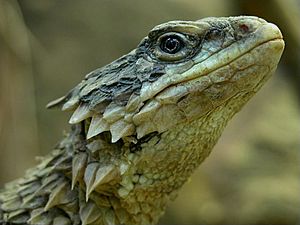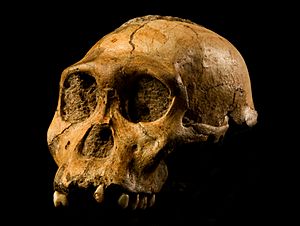John Talbot Robinson facts for kids
John Talbot Robinson (born 10 January 1923, died 12 October 2001) was a famous South African scientist. He was a paleontologist, which means he studied ancient life, especially early humans. His most exciting discovery, made with Robert Broom, was a nearly complete fossil skull. It belonged to an early human ancestor called Australopithecus africanus, and it's famously known as Mrs. Ples.
Quick facts for kids
John Talbot Robinson
|
|
|---|---|
| Born | 10 January 1923 Elliot, South Africa
|
| Died | 12 October 2001 (aged 78) |
| Alma mater | University of Cape Town |
| Spouse(s) | Sybil Clara Frances Robinson (née Dee) |
| Children | Richard John Robinson Peter Francis Robinson |
| Scientific career | |
| Fields | Hominin paleontologist |
| Institutions | University of Wisconsin–Madison |
| Thesis | The Dentition of the Australopithecinae (1955) |
Contents
Early Life and Studies
John Talbot Robinson was born in Elliot, South Africa, on 10 January 1923. His family came from British settlers who arrived in South Africa in 1820.
He went to the University of Cape Town. There, he studied zoology (the study of animals) and bacteriology (the study of tiny living things called bacteria). He earned his first degree in 1943 and a master's degree in 1944. For his master's, he wrote about the giant girdled lizard.
Robinson also helped create two books. These books showed how to dissect (carefully cut open and study) animals. One was about the clawed frog, and the other was about the spiny dogfish shark.
Starting a Career in Paleontology
Robinson began studying marine biology in Cape Town. But in late 1945, he moved to the Transvaal Museum in Pretoria. He took a job as an "assistant professional officer."
At the museum, a very important paleontologist named Robert Broom was working. Broom was known for finding early human fossils. The museum needed someone to help Broom keep track of his fossil discoveries. This is where Robinson came in.
Discovering Ancient Humans
In April 1946, Robinson became Robert Broom's assistant. They worked together for four years until Broom passed away in 1951. Their main goal was to find fossils of early humans.
They focused their excavations (digging for fossils) at several cave sites. These included Sterkfontein, Swartkrans, and Kromdraai.
Their most famous find was "Mrs. Ples" in 1947. This was a fossil skull of Australopithecus africanus, an early human ancestor. They also found many fossils of Paranthropus robustus and Telanthropis capensis. These discoveries showed that different early human species lived at the same time.
Between 1946 and 1952, Robinson and Broom published many books and articles together. After Broom's death, Robinson continued his important work with another scientist, C.K. Brain.
In 1955, Robinson earned his PhD in zoology from the University of Cape Town. His main work for this degree was about the teeth of the Australopithecinae. This study is considered one of his most important contributions. He then became the head of the Vertebrate Paleontology and Physical Anthropology department at the Transvaal Museum. Later, he became the assistant director of the museum.
Moving to the United States
In 1963, Robinson became a professor at the University of Wisconsin–Madison in the United States. He taught courses on evolutionary theory and human origins. He also taught zoology and anthropology. He worked there until he retired in 1983. Even after moving, Robinson often returned to South Africa to continue his research.
Why His Discoveries Mattered
When Robinson started working with Broom in 1946, scientists were just beginning to accept that early human ancestors had been found in South Africa. But exactly how humans evolved from early primates was still a big mystery.
The fossils found by Robinson and Broom were very important. Before 1959, their discoveries were the most complete examples of australopithecines known to science.
Understanding Early Human Evolution
The discovery of "Mrs. Ples" in 1947 was a huge step. It helped scientists understand that australopithecines were indeed ancestors of modern humans. Robinson then explained how these early humans adapted to their environment. He showed how their body features fit into the bigger picture of human evolution.
He also helped establish that two different groups of hominids (early humans and their close relatives) lived in the past.
Robinson was the first to study how the bodies of australopithecines worked. He proved that they were "committed bipeds." This means they regularly walked on two legs, just like modern humans. He published these findings in his 1976 book, Early Hominid Posture and Locomotion.
The discovery of both Paranthropus robustus and Telanthropis capensis at Swartkrans was also very important. It was the first clear proof that two different hominid species lived at the same time in Africa during the Pleistocene era. This idea was later confirmed by other fossil sites across Africa.
Personal Life
John Talbot Robinson passed away in Madison, Wisconsin, in 2001. He was survived by his wife, Sybil Robinson. She was a professor at the University of Wisconsin-Madison in the Department of Theatre and Drama.
See also
- Missing link (human evolution)



